Closing up Shop
We've just packed up all the science equipment and are heading off to Longyearbyen where we'll spend our last two days before coming back to the U.S.
 Moving the boxes to the dock where they can be shipped home
Moving the boxes to the dock where they can be shipped home
I want to take the opportunity to close out my time in Ny Ålesund by writing a bit about this remarkable community. We all shout out a huge "THANKS!" to our hosts here from Kings Bay and the Norwegian Polar Institute who have helped make this a wonderful month! Given how comfortable this little town is, it's not that hard to forget that you're in the Arctic. (That is, until you realize the sun isn't setting and you see glaciers everywhere...)
 Ny Ålesund on a sunny day. The Blue House is the German Station.
Ny Ålesund on a sunny day. The Blue House is the German Station.
Ny Ålesund
Recently I was invited to spend some time with Hallvar Gisnås, who as "Research Advisor" coordinates the scientific research here in Ny Ålesund. He gave me an overview of the town, some of which I include below. Like just about everyone else I have met here, Hallvar has an interesting story about coming here. He had worked as a software engineer in Southern Norway, and had always been fascinated by the Arctic. When the job opened up, he jumped at the chance. A nice connection for him is that his father had been here in 1965 as a field assistant with the Nowegian Polar Institute – he has kept his father's diary of that time, so it was a special experience for him to come here. Hallvar also talked to me a bit about what it's like to live here in winter. His description of living here in the 24-hour night made it sound a lot more interesting than I would have thought. He described seeing the Northern Lights and how amazing it is to see the town by moonlight all day long. He mentioned that, because of the Gulf Stream, it doesn't get as cold here in the winter as one might think.
 Hallvar Gisnås, the Research Advisor at Ny Ålesund
Hallvar Gisnås, the Research Advisor at Ny Ålesund
Ny Ålesund has some history – it began as a coal mining town back around a hundred years ago. You can still see remnants of the coal mining days when hiking up behind the town, and there's a little train preserved here, that presumably brought coal down from the hills to the port.
 One of the many sites in the vicinity of Ny Ålesund where you can see remnants of the coal mining days. Even though this is basically a pile of junk, the Norwegian government considers artifacts from this time 'cultural heritage' and you are forbidden from disturbing it!
One of the many sites in the vicinity of Ny Ålesund where you can see remnants of the coal mining days. Even though this is basically a pile of junk, the Norwegian government considers artifacts from this time 'cultural heritage' and you are forbidden from disturbing it!
The coal mining facility here came to an abrupt end in 1962 after a disastrous accident that killed 21 miners. (Apparently this accident became a nationwide scandal; in fact the prime minister of Norway had to resign as a result of this incident.)
The coal mining operation was run by a government-run company called "King's Bay". (The name of the fjord here, Kongsfjorden, means King's Bay.) During the height of the coal mining days, there were up to 400 people living here.
After the accident closed down the mining operation, Ny Ålesund was transformed into a research base for polar research. Initially it was the Norwegian Polar Institute doing the research here, but over time the scientific community grew to include researchers from many countries.
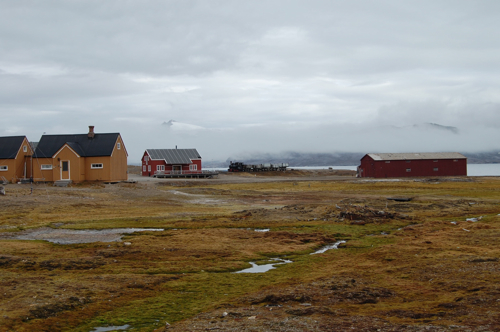 Ny Ålesund. You can see in the center the old train from the coal mining days that has been preserved. To the left, in the little red house, is the 'Mellageret Cafe' where the whole town hangs out on Saturday night.
Ny Ålesund. You can see in the center the old train from the coal mining days that has been preserved. To the left, in the little red house, is the 'Mellageret Cafe' where the whole town hangs out on Saturday night.
A Truly International Community
Because access to polar research is so easy here, at least 12 countries have a permanent "base" here. This means that they run their own living and laboratory space, with an agreement from King's Bay, which still runs Ny Ålesund.
 Ny Ålesund. The Sverdrup Station (the Norwegian Polar Institute building) is on the left. That's the building where I did my webinars.
Ny Ålesund. The Sverdrup Station (the Norwegian Polar Institute building) is on the left. That's the building where I did my webinars.
For a variety of reasons, the United States does not have its own permanent base here; instead American researchers can rent space from the Norwegian Polar Institute, which is our group has done.
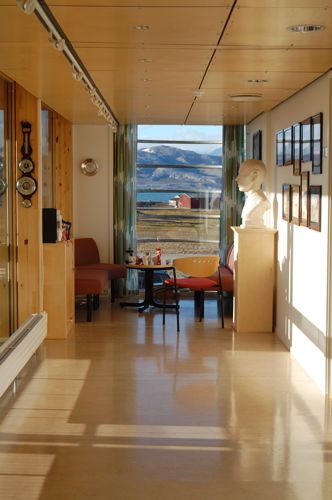 Inside the Sverdrup Station. You can see a bust of Sverdrup, who was a famous Norwegian oceanographer and polar explorer.
Inside the Sverdrup Station. You can see a bust of Sverdrup, who was a famous Norwegian oceanographer and polar explorer.
At the height of summer, around 150 people can be housed here. Throughout the year there are 26 permanent employees of King's Bay plus the Nowegians, French and Germans have a few permanent employees themselves, for a total of around 36 people.
This town is restricted to people connected in some way to scientific research being conducted here, and in order to be accepted to base your project here there are some rigorous standards that must be met. Most scientists and employees of King's Bay come in and out via the small airport, flying in from Longyearbyen.
(Tourists can come by boat but there are many restrictions on what they can do and where they can go in town – so as not to disturb the fragile ecology here and the scientists at work. We've become used to seeing groups of tourists milling around looking at the various historical markers in town, and then leaving after an hour or so.)
 The Ny Ålesund 'Butikken' (store), where you can buy tourist stuff, snacks and drinks. (Photo from Julie Brigham-Grette)
The Ny Ålesund 'Butikken' (store), where you can buy tourist stuff, snacks and drinks. (Photo from Julie Brigham-Grette)
A Melting Pot of Exciting Science
There's so much great research going on here – I wish I had time to see it all! In a previous post I wrote about my experience with the international group of bird researchers, and also about seeing the Italian atmospheric monitoring station.
Today Liz and I went up to the Ny Ålesund "Geodetic Observatory", which includes a lage radio antenna next to the airport (you may have noticed this landmark in some of my photos). This impressive-looking installation is part of a worldwide network to monitor the shape of the Earth. That's right – the shape of the Earth is not a static sphere, but changes over time as its mass shifts. Factors that might affect the shifting of mass include the motion of the molten material deep inside the Earth, plate tectonic activity (the movement of the Earth's continental plates), ocean currents, and simply the wobble of the Earth's orbit. They also monitor the Earth's rotation rate and the position of its axis, both of which vary slightly over time.
 The Geodetic Observatory in Ny Ålesund. This is part of a world-wide network to monitor the shape of the Earth and subtle changes in its rotation. This is important data for GPS satellites and spacecraft communications among other things.
The Geodetic Observatory in Ny Ålesund. This is part of a world-wide network to monitor the shape of the Earth and subtle changes in its rotation. This is important data for GPS satellites and spacecraft communications among other things.
The way they do this is by choosing a star (a pulsar, which is a pulsing star, to be precise), and recording the radio waves emitted by this star. They then compare the signal received with the same signal received by other radio antennae around the world. Each antenna will receive the signal at a slightly different time – this corresponds to the difference in distance between the star and the different positions on Earth. From this data they can detect changes in the Earth's shape and rotation. Pretty cool stuff! They spent over an hour chatting with us about their research and about the international community that they are a part of.
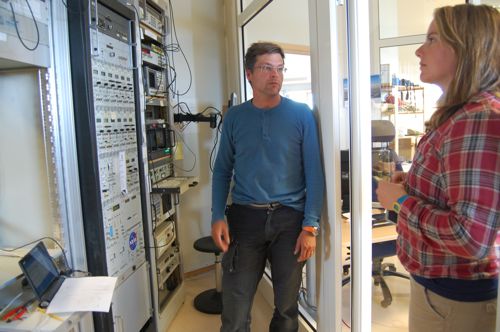 Inside the Geodetic Observatory - you can see the main computers that run the radio antenna
Inside the Geodetic Observatory - you can see the main computers that run the radio antenna
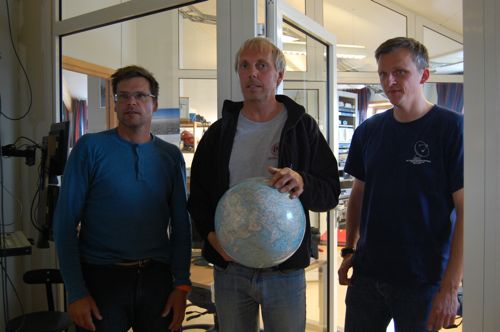 The Geodetic Observatory engineers. Geir holds a globe which he uses in explaining the operation of the Geodetic observatory system.
The Geodetic Observatory engineers. Geir holds a globe which he uses in explaining the operation of the Geodetic observatory system.
For me as a physics guy I found this place fascinating. They even have an old atomic clock from NASA!
 An atomic clock in the Geodetic Observatory, originally from NASA.
An atomic clock in the Geodetic Observatory, originally from NASA.
 Anton, a Swedish fellow we've become friendly with - he's been working at the Geodetic Observatory as a summer job. Not a bad summer gig!
Anton, a Swedish fellow we've become friendly with - he's been working at the Geodetic Observatory as a summer job. Not a bad summer gig!
This evening we were treated to a little celebration of the 20th anniversary of the German weather observatory. They let off two weather balloons in celebration (along with a little champagne!)
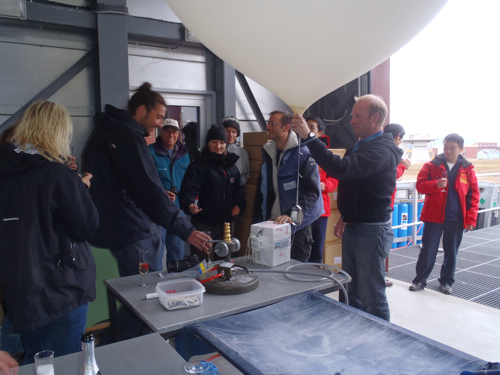 Celebrating the 20th anniversary of the Weather Observatory. Rudolf, the coordinator for the French and German station, gets the first weather balloon ready.
Celebrating the 20th anniversary of the Weather Observatory. Rudolf, the coordinator for the French and German station, gets the first weather balloon ready.
 Celebrating the 20th anniversary of the Weather Observatory. I get a chance to sign the 2nd weather balloon.
Celebrating the 20th anniversary of the Weather Observatory. I get a chance to sign the 2nd weather balloon.
All the comforts of home, and then some!
As for the hospitality here in Ny Ålesund, I was so impressed by the welcome we received from the King's Bay employees – I felt like I was checking into nice hotel! My room is modern and clean and I have my own bathroom. It even has an ethernet port for the internet. It has been nice after a long day to unwind in my room and to check email or skype my family.
 My room in the Evenstad building. As you can see, it is quite comfortable and bright - a great place to stay for 4 weeks.
My room in the Evenstad building. As you can see, it is quite comfortable and bright - a great place to stay for 4 weeks.
 The Evenstad building where I stayed during our time here in Ny Ålesund
The Evenstad building where I stayed during our time here in Ny Ålesund
The dining facility is also amazing. At every meal there were many delicious options, and since it's served buffet style I somehow always managed to eat too much! A supply ship delivers fresh food only about once a month, and it's really quite incredible to see how the chefs manage to keep the food tasty and fresh with lots of variety – even at the end of the month! Of course we noticed the abundance of lettuce and fresh fruit after the supply ship came in last week, but I am impressed at how good the food was even at the end of the last month.
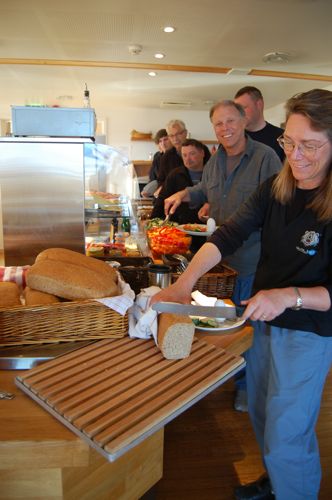 Julie and Ross in the breakfast line
Julie and Ross in the breakfast line
 The REU group at a Saturday night dinner. On Saturday night dinner is a little more special. They have tablecloths and candles, and you can bring wine and beer to dinner. Joining us 2nd from right is Stefan, one of the cooks who brings us delicious meals every night.
The REU group at a Saturday night dinner. On Saturday night dinner is a little more special. They have tablecloths and candles, and you can bring wine and beer to dinner. Joining us 2nd from right is Stefan, one of the cooks who brings us delicious meals every night.
One of the side effects of eating so well is that I think I've gained a little weight... well, all the more reason that I've tried to go to the little gym here on occasion. Most days I haven't had time to go, but this week as things have wound down I've found time to do a little running - either in the gym, or outside (if someone is willing to be my 'polar bear guard' and ride along with me on a bike carrying a rifle).
 Out for a morning run with Rebecca who escorted me on a bike so she could hold the rifle. Any time we leave town we must have a rifle in case of a polar bear encounter.
Out for a morning run with Rebecca who escorted me on a bike so she could hold the rifle. Any time we leave town we must have a rifle in case of a polar bear encounter.
Reducing our Footprint
King's Bay makes a strong effort to limit its environmental footprint. This is certainly a challenge up here in the Arctic, as the land itself is extremely fragile. This is Arctic Tundra; the ground below is permafrost, which means that below a foot or so it remains frozen all year round. Anything that grows on the tundra is extremely fragile. There are clearly marked paths and we are expected to stay on those paths. Surrounding the town are bird sanctuaries for Snow Geese, Arctic Terns and other birds. The only people allowed in the sanctuary are scientists studying those particular birds.
Any solid waste produced here must be shipped out. To that end, the town recycles just about anything you can imagine. There is a very complicated system of recycling which I found very impressive.
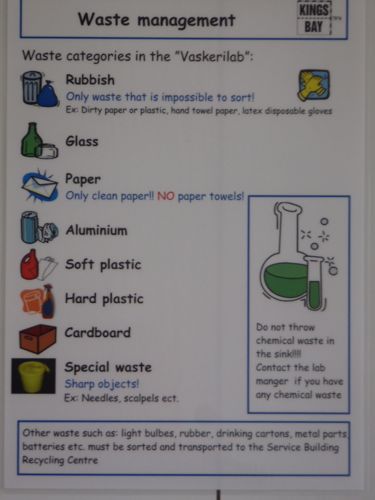 One of the many signs showing how to sort your waste here in Ny Ålesund.
One of the many signs showing how to sort your waste here in Ny Ålesund.
 The main waste sorting area in the main building.
The main waste sorting area in the main building.
A Shout Out to the People of Kings Bay!
 The polar bear statue in the dining area
The polar bear statue in the dining area
Overall, I am going to remember this remarkable little town quite fondly - I didn't get a chance to get to know as many people as I would have liked, but everyone we have come in contact with here has been wonderful. Thank you to everyone who helps to make it a comfortable and fun place to do research!
 Ny Ålesund on a cloudy day.
Ny Ålesund on a cloudy day.
